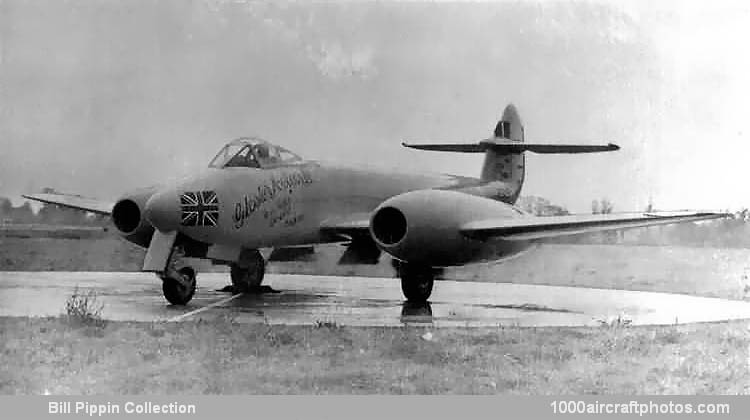02/28/2010. Remarks by Johan Visschedijk: "Following successful flight tests with long-chord nacelles on a Meteor F.Mk.I, s/n EE211, during which its sea level maximum speed had been increased by 60 mph (97 kmh), Gloster undertook an intensive program to develop the high-speed, high-altitude characteristics of the Meteor. Concurrently Rolls-Royce were producing a scaled-down version of their 4,000 lb (1,814 kg) thrust Nene engine, which had been too big to fit into the Meteor's engine bay. Named Derwent 5, it successfully passed a 100 hr test at a 3,000 lb (1,361 kg) thrust rating and was first flown in a Meteor F.Mk.III, s/n EE360, by Eric Greenwood on May 17, 1945.
The Service version of this aircraft, designated Meteor F.Mk.4, was extensively modified to meet the requirements of the increased performance. Changes from the F.Mk.III included a strengthened airframe, which gave an ultimate strength pull-out factor of 10 at 500 mph (805 kmh), and a pressurized cockpit. With a gross weight of 14,460 lb (6559 kg), the Meteor F.Mk.4 was cleared for a maximum level speed of 600 mph (966 kmh) at sea level and 630 mph (1,014 kmh) at 30,000 ft (9,144 m), which altitude was reached in a 6 min climb.
In the autumn of 1945 two Meteor F.Mk.IIIs, s/n EE454 and EE455, were taken from the production line, brought up to F.Mk.4 standard, less VHF mast and armament, and given a special high-speed finish for an attack on the world's speed record by the re-formed RAF High Speed Flight. On November 7, 1945, Group Captain H.J. Wilson in s/n EE454, set a new record of 606 mph (975 kmh) at Herne Bay, and on the same day Eric Greenwood achieved 603 mph (970 kmh) in s/n EE455, which had an all over yellow finish to make it easily discernible by the recording cameras."
